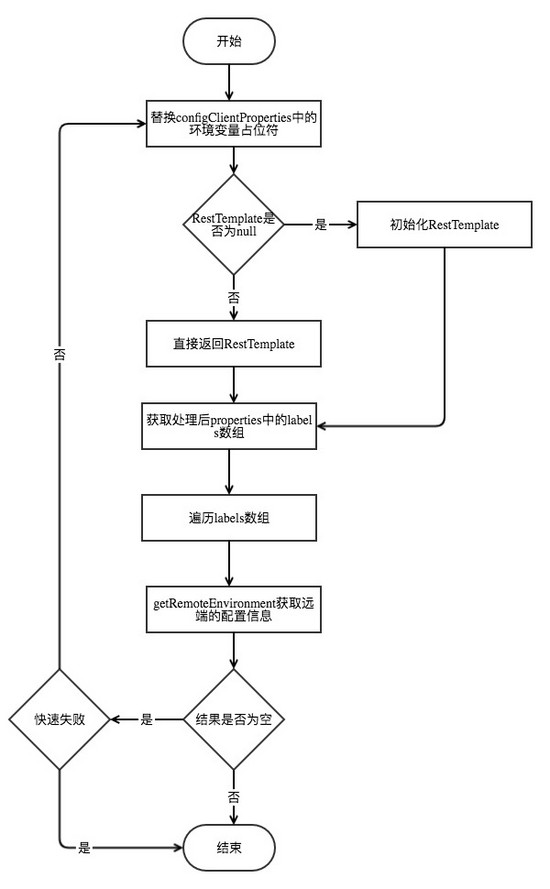您好,登录后才能下订单哦!
这篇文章主要介绍Spring Cloud覆写远端配置属性的示例分析,文中介绍的非常详细,具有一定的参考价值,感兴趣的小伙伴们一定要看完!
应用的配置源通常都是远端的Config Server服务器,默认情况下,本地的配置优先级低于远端配置仓库。如果想实现本地应用的系统变量和config文件覆盖远端仓库中的属性值,可以通过如下设置:
spring: cloud: config: allowOverride: true overrideNone: true overrideSystemProperties: false
overrideNone:当allowOverride为true时,overrideNone设置为true,外部的配置优先级更低,而且不能覆盖任何存在的属性源。默认为false
allowOverride:标识overrideSystemProperties属性是否启用。默认为true,设置为false意为禁止用户的设置
overrideSystemProperties:用来标识外部配置是否能够覆盖系统属性,默认为true
客户端通过如上配置,可以实现本地配置优先级更高,且不能被覆盖。由于我们基于的Spring Cloud当前版本是 Edgware.RELEASE ,上面的设置并不能起作用,而是使用了 PropertySourceBootstrapProperties 中的默认值。具体情况见issue: https://github.com/spring-cloud/spring-cloud-commons/pull/250 ,我们在下面分析时会讲到具体的bug源。
源码分析
ConfigServicePropertySourceLocator
覆写远端的配置属性归根结底与客户端的启动时获取配置有关,在获取到配置之后如何处理?我们看一下spring cloud config中的资源获取类 ConfigServicePropertySourceLocator 的类图。

ConfigServicePropertySourceLocator 实质是一个属性资源定位器,其主要方法是 locate(Environment environment) 。首先用当前运行应用的环境的application、profile和label替换configClientProperties中的占位符并初始化RestTemplate,然后遍历labels数组直到获取到有效的配置信息,最后还会根据是否快速失败进行重试。主要流程如下:

locate(Environment environment) 调用 getRemoteEnvironment(restTemplate, properties, label, state) 方法通过http的方式获取远程服务器上的配置数据。实现也很简单,显示替换请求路径path中占位符,然后进行头部headers组装,组装好了就可以发送请求,最后返回结果。
在上面的实现中,我们看到获取到的配置信息存放在 CompositePropertySource ,那是如何使用它的呢?这边补充另一个重要的类是PropertySourceBootstrapConfiguration,它实现了ApplicationContextInitializer接口,该接口会在应用上下文刷新之前 refresh() 被回调,从而执行初始化操作,应用启动后的调用栈如下:
SpringApplicationBuilder.run() -> SpringApplication.run() -> SpringApplication.createAndRefreshContext() -> SpringApplication.applyInitializers() -> PropertySourceBootstrapConfiguration.initialize() PropertySourceBootstrapConfiguration
而上述 ConfigServicePropertySourceLocator 的locate方法会在initialize中被调用,从而保证上下文在刷新之前能够拿到必要的配置信息。具体看一下initialize方法:
public class PropertySourceBootstrapConfigurationimplements
ApplicationContextInitializer<ConfigurableApplicationContext>, Ordered {
private int order = Ordered.HIGHEST_PRECEDENCE + 10;
@Autowired(required = false)
private List<PropertySourceLocator> propertySourceLocators = new ArrayList<>();
@Override
public void initialize(ConfigurableApplicationContext applicationContext){
CompositePropertySource composite = new CompositePropertySource(
BOOTSTRAP_PROPERTY_SOURCE_NAME);
//对propertySourceLocators数组进行排序,根据默认的AnnotationAwareOrderComparator
AnnotationAwareOrderComparator.sort(this.propertySourceLocators);
boolean empty = true;
//获取运行的环境上下文
ConfigurableEnvironment environment = applicationContext.getEnvironment();
for (PropertySourceLocator locator : this.propertySourceLocators) {
//遍历this.propertySourceLocators
PropertySource<?> source = null;
source = locator.locate(environment);
if (source == null) {
continue;
}
logger.info("Located property source: " + source);
//将source添加到PropertySource的链表中
composite.addPropertySource(source);
empty = false;
}
//只有source不为空的情况,才会设置到environment中
if (!empty) {
//返回Environment的可变形式,可进行的操作如addFirst、addLast
MutablePropertySources propertySources = environment.getPropertySources();
String logConfig = environment.resolvePlaceholders("${logging.config:}");
LogFile logFile = LogFile.get(environment);
if (propertySources.contains(BOOTSTRAP_PROPERTY_SOURCE_NAME)) {
//移除bootstrapProperties
propertySources.remove(BOOTSTRAP_PROPERTY_SOURCE_NAME);
}
//根据config server覆写的规则,设置propertySources
insertPropertySources(propertySources, composite);
reinitializeLoggingSystem(environment, logConfig, logFile);
setLogLevels(environment);
//处理多个active profiles的配置信息
handleIncludedProfiles(environment);
}
}
//...
}下面我们看一下,在 initialize 方法中进行了哪些操作。
根据默认的 AnnotationAwareOrderComparator 排序规则对propertySourceLocators数组进行排序
获取运行的环境上下文ConfigurableEnvironment
遍历propertySourceLocators时
调用 locate 方法,传入获取的上下文environment
将source添加到PropertySource的链表中
设置source是否为空的标识标量empty
source不为空的情况,才会设置到environment中
返回Environment的可变形式,可进行的操作如addFirst、addLast
移除propertySources中的bootstrapProperties
根据config server覆写的规则,设置propertySources
处理多个active profiles的配置信息
初始化方法 initialize 处理时,先将所有PropertySourceLocator类型的对象的 locate 方法遍历,然后将各种方式得到的属性值放到CompositePropertySource中,最后调用 insertPropertySources(propertySources, composite) 方法设置到Environment中。Spring Cloud Context中提供了覆写远端属性的 PropertySourceBootstrapProperties ,利用该配置类进行判断属性源的优先级。
private void insertPropertySources(MutablePropertySources propertySources,
CompositePropertySource composite) {
MutablePropertySources incoming = new MutablePropertySources();
incoming.addFirst(composite);
PropertySourceBootstrapProperties remoteProperties = new PropertySourceBootstrapProperties();
new RelaxedDataBinder(remoteProperties, "spring.cloud.config")
.bind(new PropertySourcesPropertyValues(incoming));
//如果不允许本地覆写
if (!remoteProperties.isAllowOverride() || (!remoteProperties.isOverrideNone()
&& remoteProperties.isOverrideSystemProperties())) {
propertySources.addFirst(composite);
return;
}
//overrideNone为true,外部配置优先级最低
if (remoteProperties.isOverrideNone()) {
propertySources.addLast(composite);
return;
}
if (propertySources
.contains(StandardEnvironment.SYSTEM_ENVIRONMENT_PROPERTY_SOURCE_NAME)) {
//根据overrideSystemProperties,设置外部配置的优先级
if (!remoteProperties.isOverrideSystemProperties()) {
propertySources.addAfter(
StandardEnvironment.SYSTEM_ENVIRONMENT_PROPERTY_SOURCE_NAME,
composite);
}
else {
propertySources.addBefore(
StandardEnvironment.SYSTEM_ENVIRONMENT_PROPERTY_SOURCE_NAME,
composite);
}
}
else {
propertySources.addLast(composite);
}
}上述实现主要是根据 PropertySourceBootstrapProperties 中的属性,调整多个配置源的优先级。从其实现可以看到 PropertySourceBootstrapProperties 对象的是被直接初始化,使用的是默认的属性值而并未注入我们在配置文件中设置的。
修复后的实现:
@Autowired(required = false)
private PropertySourceBootstrapProperties remotePropertiesForOverriding;
@Override
public int getOrder(){
return this.order;
private void insertPropertySources(MutablePropertySources propertySources,
CompositePropertySource composite) {
MutablePropertySources incoming = new MutablePropertySources();
incoming.addFirst(composite);
PropertySourceBootstrapProperties remoteProperties = remotePropertiesForOverriding == null
? new PropertySourceBootstrapProperties()
: remotePropertiesForOverriding;以上是“Spring Cloud覆写远端配置属性的示例分析”这篇文章的所有内容,感谢各位的阅读!希望分享的内容对大家有帮助,更多相关知识,欢迎关注亿速云行业资讯频道!
免责声明:本站发布的内容(图片、视频和文字)以原创、转载和分享为主,文章观点不代表本网站立场,如果涉及侵权请联系站长邮箱:is@yisu.com进行举报,并提供相关证据,一经查实,将立刻删除涉嫌侵权内容。